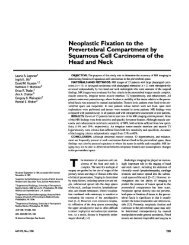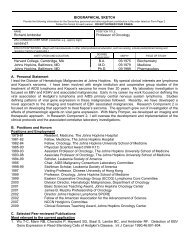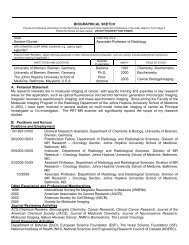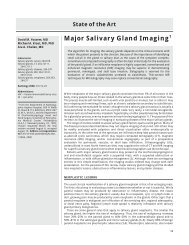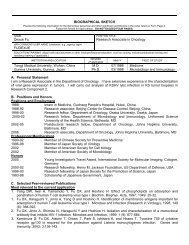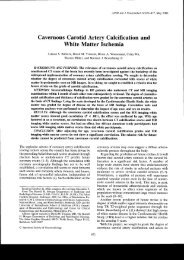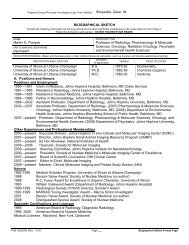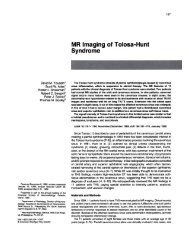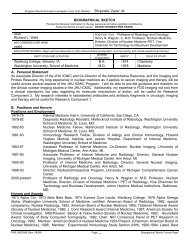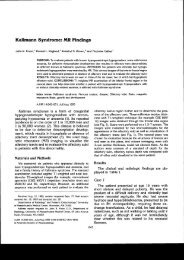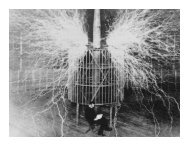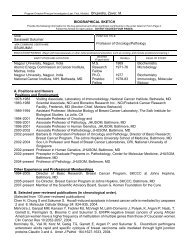The Johns Hopkins Hospital Schools of Medical Imaging ...
The Johns Hopkins Hospital Schools of Medical Imaging ...
The Johns Hopkins Hospital Schools of Medical Imaging ...
Create successful ePaper yourself
Turn your PDF publications into a flip-book with our unique Google optimized e-Paper software.
<strong>The</strong> <strong>Johns</strong> <strong>Hopkins</strong> <strong>Hospital</strong><br />
<strong>Schools</strong> <strong>of</strong> <strong>Medical</strong> <strong>Imaging</strong><br />
Radiography Program<br />
2012-2014<br />
Sponsored by the Russell H. Morgan Department <strong>of</strong> Radiology and Radiologic Sciences<br />
<strong>of</strong><br />
<strong>The</strong> <strong>Johns</strong> <strong>Hopkins</strong> <strong>Hospital</strong><br />
<strong>The</strong> <strong>Johns</strong> <strong>Hopkins</strong> <strong>Hospital</strong><br />
<strong>Schools</strong> <strong>of</strong> <strong>Medical</strong> <strong>Imaging</strong><br />
600 North Wolfe Street<br />
Blalock B-179<br />
Baltimore, MD 21287<br />
Phone 410-528-8208<br />
Web Page: http://schools<strong>of</strong>medicalimaging.rad.jhmi.edu<br />
Fax: 410-538-8308<br />
Catalog Revision and Publication Date: March 2012<br />
(Volume One)<br />
1
<strong>The</strong> <strong>Johns</strong> <strong>Hopkins</strong> <strong>Hospital</strong><br />
<strong>Schools</strong> <strong>of</strong> <strong>Medical</strong> <strong>Imaging</strong><br />
Radiography Program<br />
2012-2014<br />
Table <strong>of</strong> Contents<br />
Content Area Page Content Area Page<br />
Student Privacy Rights 3 Financial Aid 13<br />
Non-Discriminatory Policy 3 VA Approved Program 14<br />
History <strong>of</strong> <strong>Johns</strong> <strong>Hopkins</strong> 4 Refund Policy 14<br />
Program Mission Statement 4 Student Records and Transcripts 15<br />
Radiography Goals and Outcomes 5 Health Insurance 15<br />
Program Effectiveness Data 5 Graduation Requirements 15<br />
Overview <strong>of</strong> the Program 6 Program Schedule 15<br />
Accreditation and Approval 6 Resources and Services 16<br />
Administration and Faculty 7 Absentee and Leave Policy 17<br />
Radiography Program Faculty 7 Lateness 18<br />
Student Instructor Ratios 7 Attendance Management 19<br />
Academic Calendar 2012-2013 7 Leave <strong>of</strong> Absence 19<br />
Academic Calendar 2013-2014 8 Inclement Weather Policy 19<br />
Applications and Admission 9 Disciplinary Policies 20<br />
Prerequisite Coursework 10 Dismissal Policy 20<br />
Physical Health Examination 10 Grievance Policy 21<br />
Background Check 11 JRCERT Appeal Process 22<br />
Technical Requirements 11 MHEC Appeal Process 22<br />
Associates Degree Requirement 1/1/15 11 Grading Policies 23<br />
Degree Options 12 Academic Integrity Policy 24<br />
Transfer Credit Policy 13 Radiography Program Course Hours 24<br />
Tuition and Fees 13 Radiography Course Descriptions 25<br />
Payment <strong>of</strong> Tuition 13<br />
2
Statement Regarding the Privacy Rights <strong>of</strong> Students<br />
<strong>The</strong> <strong>Johns</strong> <strong>Hopkins</strong> <strong>Hospital</strong> <strong>Schools</strong> <strong>of</strong> <strong>Medical</strong> <strong>Imaging</strong> is prepared to comply with the<br />
provisions <strong>of</strong> the Families Educational Rights and Privacy Act <strong>of</strong> 1974 (Public Law 90-247, as<br />
amended) and any regulations that may be promulgated there under. Students and others who<br />
may wish specific information regarding the rights <strong>of</strong> access to institutional educational records<br />
maintained in their names are advised to contact the Program Director.<br />
Notice <strong>of</strong> Nondiscriminatory Policy as to Students<br />
<strong>The</strong> <strong>Johns</strong> <strong>Hopkins</strong> <strong>Hospital</strong> <strong>Schools</strong> <strong>of</strong> <strong>Medical</strong> <strong>Imaging</strong> admits students <strong>of</strong> any race, color, sex,<br />
disability and national or ethnic origin to all <strong>of</strong> the rights, privileges, program benefits and<br />
activities generally accorded or made available to students at the <strong>Schools</strong> <strong>of</strong> <strong>Medical</strong> <strong>Imaging</strong>.<br />
Certified to be true and correct <strong>of</strong> content:<br />
Sandra E. Moore, MA, RT(R)(M)<br />
Radiography Program Director<br />
<strong>The</strong> <strong>Johns</strong> <strong>Hopkins</strong> <strong>Hospital</strong>, <strong>Schools</strong> <strong>of</strong> <strong>Medical</strong> <strong>Imaging</strong><br />
410-528-8210<br />
semoore@jhmi.edu<br />
April 1, 2012<br />
3
History<br />
<strong>The</strong> <strong>Johns</strong> <strong>Hopkins</strong> <strong>Medical</strong> Institutions were established through a gift <strong>of</strong> a Quaker merchant,<br />
<strong>Johns</strong> <strong>Hopkins</strong>, who wanted the <strong>Hospital</strong> and University built as a joint venture.<br />
<strong>Johns</strong> <strong>Hopkins</strong> was born into a very poor family in southern Maryland in 1795. His first name<br />
was inherited from his great-great-grandfather, Richard <strong>Johns</strong>. Because <strong>of</strong> the family’s financial<br />
troubles, he was forced to quit school at the age <strong>of</strong> 12. He went to work for his uncles and by the<br />
age <strong>of</strong> 19 he had established himself as a respected merchant.<br />
Eventually he went into business for himself and built a fortune <strong>of</strong> 7 million dollars before he<br />
died in 1873 at the age <strong>of</strong> 78. <strong>Hopkins</strong> never married but gave much thought to what would<br />
happen to his estate. He left 3.5 million dollars to build a hospital, for he said “<strong>The</strong>re will always<br />
be suffering.” He also left 3.5 million dollars to build a joint university, “for there will always be<br />
youth.” His concept <strong>of</strong> the <strong>Hospital</strong> and the University as a joint venture was a revolutionary idea<br />
at the time that set the standard for future medical education in the United States.<br />
In his will he specified that the <strong>Hospital</strong> was “forever to serve the sick and ill <strong>of</strong> Baltimore<br />
without regard to race, age, sex or the ability to pay.” Drs. Welch and Osler, two <strong>of</strong> the famous<br />
“<strong>Hopkins</strong> Four’, brought other philosophies into the pattern <strong>of</strong> medical education in patient<br />
centered medical training and scientific research. Before the <strong>Hospital</strong> was established, physicians<br />
trained at medical schools without ever examining a real patient. <strong>The</strong> pattern established at <strong>The</strong><br />
<strong>Johns</strong> <strong>Hopkins</strong> <strong>Hospital</strong> changed U.S. medical education forever by brining medical students to<br />
the bedside <strong>of</strong> patients and placing the practice <strong>of</strong> medicine on a scientific basis.<br />
<strong>The</strong> <strong>Johns</strong> <strong>Hopkins</strong> <strong>Hospital</strong> opened on May 7, 1898 followed four years later by <strong>The</strong> <strong>Johns</strong><br />
<strong>Hopkins</strong> University along with the School <strong>of</strong> Medicine. <strong>The</strong> opening <strong>of</strong> the University and the<br />
School <strong>of</strong> Medicine ushered in a new era <strong>of</strong> medicine. Moving from laboratory to lecture hall to<br />
the patient’s bedside, students and interns brought the scientific approach to medicine and<br />
received first-hand training in diagnosis and treatment. Within two decades, the <strong>Hospital</strong> and<br />
School <strong>of</strong> Medicine were models <strong>of</strong> medical care and education for the nation. That distinction<br />
has remained intact for over 100 years.<br />
<strong>Johns</strong> <strong>Hopkins</strong> willed 13 acres <strong>of</strong> land in the city <strong>of</strong> Baltimore to erect the <strong>Hospital</strong> and wanted it<br />
to ultimately receive 400 patients. Today, <strong>The</strong> <strong>Johns</strong> <strong>Hopkins</strong> <strong>Medical</strong> Institutions covers a 44<br />
acre area, has more than 1,000 beds, and is recognized as one <strong>of</strong> the world’s leading medical<br />
institutions.<br />
General Information<br />
Radiography Program Mission Statement:<br />
To train Radiographers <strong>of</strong> the highest caliber consistent with the standards and expectations <strong>of</strong> a<br />
graduate <strong>of</strong> <strong>The</strong> <strong>Johns</strong> <strong>Hopkins</strong> <strong>Medical</strong> Institutions.<br />
4
Radiography Program Goals and Student Learning Outcomes<br />
Goal 1:<br />
Students will demonstrate critical thinking skills in the classroom and clinical setting.<br />
Student Learning Outcomes:<br />
Students will be able to modify routine examinations to accommodate patient body<br />
habitus, pathology, trauma and physical limitations<br />
Students will demonstrate critical thinking skills when evaluation radiographs.<br />
Goal 2:<br />
Students will demonstrate skill in written and oral expression<br />
Student learning outcomes:<br />
Students will demonstrate written communication skills<br />
Students will demonstrate oral communication skills<br />
Goal 3:<br />
Students will demonstrate pr<strong>of</strong>essionalism and a commitment to life-long learning<br />
Student learning outcomes:<br />
Students will demonstrate pr<strong>of</strong>essional behavior in the clinical setting<br />
Students will demonstrate a commitment to life-long learning<br />
Goal 4:<br />
Students will demonstrate competency in entry-level radiography skills<br />
Student learning outcomes:<br />
<strong>The</strong> student will produce radiographs <strong>of</strong> diagnostic quality<br />
<strong>The</strong> student will practice radiation protections for patients, self and staff<br />
Program Effectiveness Data: ARRT pass rate: 2007 - 2011<br />
<strong>The</strong> Radiography program’s 5 year average pass rate on the credentialing examination is<br />
1 100% on the first attempt.<br />
Job Placement rate: 2007 – 2011: 5 year average 92.9%<br />
2007 100.0<br />
2008 92.9<br />
2009 100.0<br />
2010 87.5<br />
2011 92.9<br />
Program Completion Rate 2007 – 2011: 5 year average is 79.2<br />
2007: 90.9%<br />
2008: 71.4%<br />
2009: 86.4%<br />
2010: 41.1%<br />
2011: 100%<br />
This information may also be viewed on the JRCERT website at www.jrcert.org<br />
5
Overview <strong>of</strong> the Program<br />
<strong>The</strong> Radiography Program is an 18 month (79 week, 3,160 clock hours) program. <strong>The</strong> program<br />
begins in June <strong>of</strong> each year and ends in December <strong>of</strong> the following year. Students will graduate<br />
with a certificate that allows them to sit for the national board examination given by the<br />
American Registry <strong>of</strong> Radiologic Technologists. <strong>The</strong> Radiography Program is part <strong>of</strong> the<br />
<strong>Schools</strong> <strong>of</strong> <strong>Medical</strong> <strong>Imaging</strong> which is administered under the direction the Russell H. Morgan<br />
Department <strong>of</strong> Radiology and Radiologic Sciences. <strong>The</strong> program faculty includes a full-time<br />
program director, as well as two full-time clinical coordinators. Clinical instructors are employed<br />
by the clinical sites. <strong>The</strong> pr<strong>of</strong>essional and technical staff <strong>of</strong> the Department <strong>of</strong> Radiology <strong>of</strong> <strong>The</strong><br />
<strong>Johns</strong> <strong>Hopkins</strong> <strong>Hospital</strong> and clinical affiliates also provides didactic and clinical instruction.<br />
<strong>The</strong> didactic portion <strong>of</strong> the Program will be <strong>of</strong>fered at the 8 Market Place, Suite 600, Baltimore,<br />
MD 21202. This location has classroom space, a lounge area and kitchen space for student,<br />
faculty <strong>of</strong>fices and a computer lab. Classrooms are fully equipped with anatomical models,<br />
computer projection system and a print library. Students will have full digital access to the<br />
Welch <strong>Medical</strong> Library, one <strong>of</strong> the largest medical libraries in the world. <strong>The</strong> classroom space is<br />
easily accessible by car, bus or subway. During the second semester <strong>of</strong> the program, one 8-week<br />
course (2 hours per week) will be held at Great Baltimore <strong>Medical</strong> Center.<br />
<strong>The</strong> clinical training in the program will be completed at <strong>The</strong> <strong>Johns</strong> <strong>Hopkins</strong> <strong>Hospital</strong> and<br />
numerous other clinical facilities in the Baltimore metropolitan area. <strong>The</strong>se facilities <strong>of</strong>fer a wide<br />
variety <strong>of</strong> state-<strong>of</strong>-the-art imaging equipment. Clinical facilities include <strong>The</strong> <strong>Johns</strong> <strong>Hopkins</strong><br />
<strong>Hospital</strong>, <strong>The</strong> <strong>Johns</strong> <strong>Hopkins</strong> Outpatient Center, <strong>Johns</strong> <strong>Hopkins</strong> Bayview <strong>Medical</strong> Center, <strong>Johns</strong><br />
<strong>Hopkins</strong> at White Marsh, Sinai <strong>Hospital</strong>, Northwest <strong>Hospital</strong>, American Radiology Services at<br />
Timonium Crossing and Annapolis and Advance Radiology at Eldersburg and Westminster.<br />
Completion <strong>of</strong> this Program, and passing the ARRT credentialing examination allows the<br />
graduate to obtain employment in a wide variety <strong>of</strong> imaging locations to include hospitals and<br />
outpatient centers. A graduate <strong>of</strong> this program will have obtained training in general radiography,<br />
fluoroscopy, orthopedic, pediatrics, surgical and trauma radiography.<br />
Accreditation and Approval<br />
<strong>The</strong> Radiography Program is accredited by:<br />
<strong>The</strong> Joint Review Committee on Education in Radiologic Technology<br />
20 N. Wacker Drive, Suite 2850<br />
Chicago, IL 60606-3182<br />
312-704-5304<br />
<strong>The</strong> <strong>Johns</strong> <strong>Hopkins</strong> <strong>Hospital</strong> <strong>Schools</strong> <strong>of</strong> <strong>Medical</strong> <strong>Imaging</strong> are approved by:<br />
Maryland Higher Education Commission<br />
6 North Liberty Street<br />
Baltimore, MD 21201<br />
410-767-3301<br />
Students may contact Maryland Higher Education to access such information as the program<br />
enrollment, completion rate, placement rate and pass rate on the credentialing examination.<br />
6
Administration and Faculty<br />
Jonathan S. Lewin, MD Radiology Department Chairman<br />
Martin Bledsoe, MSPH, RN Radiology Department Administrator<br />
Peg Cooper, MBA, RT(R) Radiology Department Administrator for Clinical Operations<br />
Jay K. Rhine, BS, CNMT Director, <strong>Schools</strong> <strong>of</strong> <strong>Medical</strong> <strong>Imaging</strong><br />
Radiography Program Faculty<br />
Jane E. Benson, MD<br />
Sandra E. Moore, MA, RT(R)(M)<br />
Alfred G. Traylor, MA, RT(R)(CT)(MR)<br />
Stacey A. Bickling, BA, RT(R)<br />
<strong>Medical</strong> Advisor<br />
Radiography Program Director: semoore@jhmi.edu<br />
Radiography Clinical Coordinator<br />
Radiography Clinical Coordinator<br />
Student Instructor Ratio<br />
Lecture: 22:1<br />
Laboratory: 3:1<br />
Clinical: 1:1<br />
Academic Calendar 2012-2013<br />
April 27, 2012 Pre-Orientation meeting for the Class <strong>of</strong> 2013<br />
June 11 – June 29, 2012 Program Orientation for Radiography, Class <strong>of</strong> 2013<br />
July 2 – July 27, 2012 Clinical Orientation<br />
July 4, 2012<br />
July 4 th Holiday, all students.<br />
September 3, 2012 Labor Day Holiday, all students<br />
October 1, 2012 2 nd tuition payment due, Class <strong>of</strong> 2013<br />
November 22, 2012 Thanksgiving Holiday, all students<br />
December 14, 2012 Graduation, Radiography Class <strong>of</strong> 2012<br />
December 25, 2012 Christmas Holiday, all students<br />
January 1, 2013<br />
New Year’s Holiday, all students<br />
January 2, 2013<br />
Second semester begins<br />
January 21, 2013<br />
Martin Luther King’s Birthday Holiday, all students<br />
February 1, 2013 3 rd tuition payment due, Class <strong>of</strong> 2013<br />
May 27, 2013<br />
Memorial Day Holiday, all students<br />
July 1, 2013<br />
Third semester begins<br />
July 1, 2013 4 th tuition Payment due Class <strong>of</strong> 2013<br />
July 4, 2013<br />
4 th <strong>of</strong> July Holiday, all students<br />
September 2, 2013 Labor Day Holiday, all students<br />
November 28, 2013 Thanksgiving Holiday, all students<br />
December 13, 2013 Graduation, Radiography, Class <strong>of</strong> 2013<br />
7
Academic Calendar 2013 -2014<br />
April 26, 2013 Pre-Orientation meeting for the Class <strong>of</strong> 2014<br />
June 10 – June 30, 2013 Program Orientation for Radiography, Class <strong>of</strong> 2014<br />
July 1 – August 2, 2013 Clinical Orientation<br />
July 4, 2013<br />
July 4 th Holiday, all students.<br />
September 2, 2013 Labor Day Holiday, all students<br />
October 1, 2013 2 nd tuition payment due, Class <strong>of</strong> 2014<br />
November 28, 2013 Thanksgiving Holiday, all students<br />
December 14, 2013 Graduation, Radiography Class <strong>of</strong> 2013<br />
December 25, 2013 Christmas Holiday, all students<br />
January 1, 2014<br />
New Years Holiday, all students<br />
January 2, 2014<br />
Second semester begins<br />
January 20, 2014<br />
Martin Luther King’s Birthday Holiday, all students<br />
February 1, 2014 3 rd tuition payment due, Class <strong>of</strong> 2014<br />
May 26, 2014<br />
Memorial Day Holiday, all students<br />
July 1, 2014<br />
Third semester begins<br />
July 1, 2014 4 th tuition Payment due Class <strong>of</strong> 2014<br />
July 4, 2014<br />
4 th <strong>of</strong> July Holiday, all students<br />
September 1, 2014 Labor Day Holiday, all students<br />
November 27, 2014 Thanksgiving Holiday, all students<br />
December 13, 2014 Graduation, Radiography, Class <strong>of</strong> 2014<br />
8
Applications and Admission<br />
For consideration into the Radiography Program, all applications and application fees must be<br />
postmarked by December 31 st for the program that begins the following June. All supporting<br />
documents and transcripts must be received no later than January 15 th <strong>of</strong> the matriculation year.<br />
Applications postmarked after December 31 st or failure to supply supporting documents by<br />
January 15 th , will only be considered on a space-available basis. It is the responsibility <strong>of</strong> the<br />
applicant to insure that all materials are received.<br />
Complete applications include:<br />
Application fee <strong>of</strong> $40.00<br />
Completed application form (see application section)<br />
Letter <strong>of</strong> intent ( no more than one page, stating why you chose a career in the health care<br />
sciences and outlines your specific goals in Radiography<br />
Two references: one from a current employer and one from a pr<strong>of</strong>essor <strong>of</strong> math or<br />
science, completed on program forms. (see application section)<br />
Transcripts documenting all post high school education<br />
Shadow day form (see application section) Applicants must document a minimum <strong>of</strong> 4<br />
hours shadowing in a hospital setting. <strong>The</strong>se 4 hours must be completed in the diagnostic<br />
(x-ray) department only.<br />
Applicants with foreign academic degrees are required to take the TOEFL iBT examination<br />
within one year <strong>of</strong> the application deadline. Foreign transcripts must be evaluated by one <strong>of</strong> the<br />
agencies in the United States that performs academic evaluations <strong>of</strong> all prerequisite coursework<br />
and other existing coursework. <strong>The</strong> overall score on the TOEFL iBT must be 80 or greater. <strong>The</strong><br />
speaking portion <strong>of</strong> the examination must be 26 or greater.<br />
Applicants who meet the qualifications specified for the Radiography Program (see prerequisite<br />
courses) will be required to participate in a personal interview. In addition, at the time <strong>of</strong> the<br />
interview, a basic computer skills assessment test will be administered. This will consist <strong>of</strong> a<br />
timed assessment <strong>of</strong> the applicant’s ability to type a short Micros<strong>of</strong>t Word document and<br />
navigate the Internet for specified information.<br />
Note to all prospective students: Criminal convictions may affect a student’s ability to be<br />
credentialed or licensed. If a prospective student has even been charged with or convicted <strong>of</strong> a<br />
felony or misdemeanor, or has been subject to a disciplinary action (such as suspension or<br />
dismissal) from another Radiography program, the prospective student must contact the<br />
American Registry <strong>of</strong> Radiologic Technologists for a Pre-Application Review <strong>of</strong> Eligibility<br />
(615-687-0048 x8580).<br />
Acceptance decisions are based on the following:<br />
GPA in the prerequisite coursework, and in the event <strong>of</strong> a tie, GPA in all college-level<br />
coursework completed.<br />
Computer skills assessment.<br />
Interview scores.<br />
TOEFL iBT scores if applicable.<br />
Successful completion <strong>of</strong> the background check.<br />
9
Successful completion <strong>of</strong> the hospital drug screening.<br />
Successful completion <strong>of</strong> any outstanding prerequisite coursework.<br />
While acceptance decisions are not based on volunteer experience, the candidate is strongly<br />
encouraged to volunteer in a health care setting in order to solidify the student’s desire to work in<br />
a health related pr<strong>of</strong>ession.<br />
In cases where applicants are equally qualified, the program admissions committee will make the<br />
final selection.<br />
Prerequisite Coursework<br />
All students who apply to the program must meet all physical and technical health capabilities<br />
standards (see below), be <strong>of</strong> high moral integrity, demonstrate responsibility, possess good<br />
interpersonal skills and compassion. All students must have reached the age <strong>of</strong> 18 by the day <strong>of</strong><br />
matriculation.<br />
Applicants are required to have taken the following academic prerequisites at an accredited<br />
academic institution, and must have completed the required prerequisite courses with a “C” or<br />
better. <strong>The</strong> required prerequisite coursework GPA must average to 3.0 or better. Students may<br />
apply with prerequisite coursework outstanding, but all coursework must be completed prior to<br />
the matriculation date. No more than two prerequisite courses may be outstanding at the time <strong>of</strong><br />
the application.<br />
Required prerequisite courses include the following;<br />
Human Anatomy and Physiology I and II, with laboratory.<br />
College Algebra<br />
Introduction to Computers to include content in computer hardware, s<strong>of</strong>tware and Office<br />
applications<br />
<strong>The</strong> applicant must take one <strong>of</strong> the following:<br />
o English composition<br />
o Public speaking<br />
o Interpersonal communication<br />
Physical Health Examination<br />
Before the date <strong>of</strong> matriculation, all students will receive a routine physical examination free <strong>of</strong><br />
charge. Drug testing is performed as part <strong>of</strong> this physical. <strong>The</strong> <strong>Johns</strong> <strong>Hopkins</strong> <strong>Hospital</strong> and all<br />
clinical affiliates are drug-free environments and students will not be permitted to enroll if they<br />
fail the drug screening. <strong>The</strong> fee for this is $150.00.<br />
<strong>The</strong> routine physical examination, conducted by <strong>Johns</strong> <strong>Hopkins</strong> <strong>Hospital</strong> Occupational Health,<br />
will require the student to show pro<strong>of</strong> <strong>of</strong> immunity to childhood illness, such as measles, mumps,<br />
rubella and varicella. Students who fail to show immunity to these childhood diseases will be<br />
<strong>of</strong>fered the vaccines, at a reduced fee, payable by the students. Students will also receive<br />
tuberculosis skin testing at the time <strong>of</strong> the physical.<br />
10
Background Check<br />
Consistent with <strong>The</strong> <strong>Johns</strong> <strong>Hopkins</strong> <strong>Hospital</strong> policy <strong>of</strong> requiring a criminal background check for<br />
all employees, this requirement is also extended to all students accepted by the Radiography<br />
Program. <strong>The</strong> background check will be initiated by the <strong>Hospital</strong> and will be conducted by<br />
PreCheck, Inc., at a cost <strong>of</strong> $48.50 per student. This fee will become the responsibility <strong>of</strong> the<br />
student. An acceptable background screening will be required for all students beginning the<br />
Program.<br />
Physical and Technical Requirements<br />
<strong>The</strong> student will be expected to do the following:<br />
Push, pull and lift a minimum <strong>of</strong> 40 pounds<br />
Stand for long periods <strong>of</strong> time<br />
Push and maneuver wheelchairs, stretchers and portable imaging equipment.<br />
Wear lead protective clothing for periods for 2-3 hours at a time.<br />
Be capable <strong>of</strong> fine motor control to handle equipment settings, computer use and<br />
injection syringes.<br />
Auditory capabilities to hear patient requests, monitoring devices and instructions from<br />
staff or physicians.<br />
Visual acuity to distinguish shades <strong>of</strong> grey, read patient monitoring devices and see small<br />
details on the radiographic image.<br />
Perform CPR, if required.<br />
Performing twisting, lifting, pulling and carrying for purposes <strong>of</strong> moving equipment,<br />
transporting radiographic cassettes and moving patients.<br />
Prospective students who have questions about performing any <strong>of</strong> the above activities should<br />
contact the Program Director.<br />
Associates Degree Requirement January 1 st , 2015<br />
Effective January 1, 2015, the American Registry <strong>of</strong> Radiologic Technologists will require that<br />
all students must have a minimum <strong>of</strong> an associate degree in order to sit for the national board<br />
examination. (Please note that you must take and pass this examination in order to work as a<br />
technologist in the majority <strong>of</strong> locations in the United States). In order to meet this requirement,<br />
the Radiography Program must insure the following, effective with the class that enters in June<br />
2014:<br />
1. <strong>The</strong> student must already have a minimum <strong>of</strong> an associate degree before the start <strong>of</strong> the<br />
program. <strong>The</strong> specific major does not matter, only that the prospective student have a<br />
degree. OR<br />
<strong>The</strong> student may do the required prerequisite courses and general education courses at a<br />
community college or four year college or university that has affiliated with the<br />
Radiography Program. <strong>The</strong> student will complete all required prerequisite courses at the<br />
affiliated community college or four year college or university and then apply to the<br />
program. Upon successful completion <strong>of</strong> the Radiography program, the affiliated<br />
institution has agreed to accept the Radiography Program credits toward the completion<br />
<strong>of</strong> the degree. Once the degree is granted, the student will be eligible to sit for the ARRT<br />
11
oards. At this writing the program has a formal academic affiliation with Harford<br />
Community College in Maryland, Notre Dame <strong>of</strong> Maryland University in Baltimore and<br />
Bloomsburg University in Pennsylvania. More affiliations contracts are in progress. <strong>The</strong><br />
prospective student should check this page frequently for updates. Please contact the<br />
program director for clarification and questions.<br />
Please note that as <strong>of</strong> June 2014, no student will be accepted into the program who has not<br />
completed all general education classes to obtain a degree upon completion <strong>of</strong> the program,<br />
or who has not already obtained a degree before the start <strong>of</strong> the program.<br />
Degree Options<br />
Notre Dame <strong>of</strong> Maryland University, located in Baltimore, MD, <strong>of</strong>fers a program leading to a<br />
bachelors degree in Radiologic Sciences. Students will complete their prerequisite and general<br />
education coursework at NDMU, and then fulfill their degree requirements by completing an<br />
additional imaging specialty at <strong>The</strong> <strong>Johns</strong> <strong>Hopkins</strong> <strong>Hospital</strong>, or by completing a concentration in<br />
business administration at NDMU. Options for NDMU include:<br />
1. Completion <strong>of</strong> the Radiography Program and another imaging specialty area such at CT<br />
or MRI. Please note that the program in CT and MRI are highly competitive and limited<br />
in size. <strong>The</strong> student must go through an acceptance process and selection is not<br />
guaranteed. This option is only open to those students who enter into the program in June<br />
2013. <strong>The</strong>se students may also choose to complete the academic concentration in lieu <strong>of</strong><br />
an additional imaging modality.<br />
2. For those students entering into the program effective June 2014, the student must<br />
complete all general education courses, prerequisite courses, and the academic<br />
concentration in business before being admitted to the Radiography Program.<br />
Please contact the advising <strong>of</strong>fice <strong>of</strong> Notre Dame <strong>of</strong> Maryland University at 410-532-5500, or<br />
see the webpage at http://www.ndm.edu and look for the link to Adult Undergraduate Studies for<br />
further information.<br />
Bloomsburg University located in Bloomsburg, Pennsylvania, <strong>of</strong>fers a program leading to a<br />
bachelors degree in <strong>Medical</strong> <strong>Imaging</strong>. Students will complete their prerequisite and general<br />
education coursework at Bloomsburg, and then fulfill their degree requirements by completing<br />
an additional imaging specialty at <strong>The</strong> <strong>Johns</strong> <strong>Hopkins</strong> <strong>Hospital</strong>, or by completing a concentration<br />
in business or education. Options for Bloomsburg include:<br />
1. Completion <strong>of</strong> the Radiography Program and another imaging specialty area such at CT<br />
or MRI. Please note that the program in CT and MRI are highly competitive and limited<br />
in size. <strong>The</strong> student must go through an acceptance process and selection is not<br />
guaranteed. This option is only open to those students who enter into the program in June<br />
2013. <strong>The</strong>se students may also choose to complete the academic concentration in<br />
business or education in lieu <strong>of</strong> an additional imaging modality.<br />
2. For those students entering into the program effective June 2014, the student must<br />
complete all general education courses, prerequisite courses, and the academic<br />
concentration in business or education before being admitted to the Radiography Program<br />
12
Please contact the advising <strong>of</strong>fice at Bloomsburg University at 570-389-4130, or access the<br />
webpage at http://www.bloomu.edu for further information.<br />
Harford Community College, located in Bel Air Maryland <strong>of</strong>fers the opportunity for the<br />
prospective student to complete an associate degree in Technical and Pr<strong>of</strong>essional Studies. <strong>The</strong><br />
student must complete all program prerequisites and general education coursework, before being<br />
accepted into the Radiography Program. For further information please contact the advising<br />
<strong>of</strong>fice at Harford Community College at 443-412-2000, or access the webpage at<br />
http://www.harford.edu<br />
Transfer Credit Policy<br />
Transfer credit is generally not given for previous academic or clinical training in Radiography.<br />
Requests for exceptions to this policy must be addressed to the Program Director<br />
Tuition and Fees<br />
Application fee: $40.00<br />
Background Check $48.50<br />
Tuition:<br />
$6,000.00 for the entire program<br />
Physical and drug screening $150.00<br />
CPR Certification: $25.00<br />
Lab Fee:<br />
$150.00 for the entire program<br />
Uniforms: $300.00<br />
Books: $1,200.00<br />
Tuition is paid in 4 equal installments during the first 13 months <strong>of</strong> the program. Please note that<br />
all tuition and fees are subject to change.<br />
Uniforms and books are purchased through the program vendors. All textbooks and uniforms<br />
specified by the program are required.<br />
Payment <strong>of</strong> Tuition<br />
It is the responsibility <strong>of</strong> the student to have tuition payments in the school <strong>of</strong>fice by the due<br />
date. Students whose tuition is in arrears will not be allowed to participate in the Program until<br />
tuition is up to date. <strong>The</strong> <strong>of</strong>fice does not send out invoices for tuition. <strong>The</strong> payment schedule for<br />
tuition is as follows:<br />
Payment 1: Due June 1 st , $1825.00 ($1500.00 tuition, physical, CPR and lab fee)<br />
Payment 2: Due October 1 st , $1500.00<br />
Payment 3: Due February 1 st , $1500.00<br />
Payment 4: Due July 1 st , $1500.00<br />
Financial Aid<br />
<strong>The</strong> <strong>Schools</strong> <strong>of</strong> <strong>Medical</strong> <strong>Imaging</strong> is recognized at an eligible institution <strong>of</strong> higher education for<br />
purposes <strong>of</strong> state financial aid programs. <strong>The</strong>se include Maryland State Scholarships and<br />
Veterans Benefits, but do not include Federal financial aid such as Pell Grants and Stafford<br />
loans. Students may apply for a low-interest loan through <strong>The</strong> <strong>Johns</strong> <strong>Hopkins</strong> Federal Credit<br />
13
Union. <strong>The</strong> applicant must meet all JHFCU requirements. <strong>The</strong> <strong>Schools</strong> <strong>of</strong> <strong>Medical</strong> <strong>Imaging</strong> does<br />
not guarantee loan approval by JHFCU. Specifics about loan policies can be addressed at the<br />
time <strong>of</strong> the applicant’s interview or through the school <strong>of</strong>fice. All financial arrangements should<br />
be resolved before attending the program. Students receiving scholarships may defer that part <strong>of</strong><br />
their tuition that will be covered by the scholarships. <strong>The</strong> remaining amount must be paid by the<br />
due date.<br />
VA Approved Program<br />
<strong>The</strong> Radiography Program is approved by the Maryland State Approving Agency to <strong>of</strong>fer<br />
training to veterans and other eligible dependants under the VA educational benefit programs.<br />
<strong>The</strong> Radiography Program will obtain written records on a VA beneficiary’s previous education<br />
and experience and complete an evaluation. <strong>The</strong> Radiography program generally does not grant<br />
credit for previous radiography training, and requests for such must be addressed to the program<br />
director.<br />
<strong>The</strong> Program will notify the VA <strong>of</strong> any change in the enrollment status <strong>of</strong> students certified to<br />
receive Veterans educational benefits. This would include when the student is placed on<br />
attendance or academic probation, changes in scheduling or termination <strong>of</strong> training.<br />
<strong>The</strong> Program will maintain grade records which are updated on a semester basis.<br />
If the students is on an <strong>of</strong>ficial leave <strong>of</strong> absence, and fails to return to training by the end <strong>of</strong> the<br />
leave <strong>of</strong> absence, a refund due to a student shall be based on the date <strong>of</strong> withdrawal or<br />
termination and paid within 60 days <strong>of</strong> the scheduled last day <strong>of</strong> the leave <strong>of</strong> absence.<br />
Uniforms, books, lab fees, application fees and CPR fees are not refundable.<br />
Refund Policy<br />
All fees paid by a student shall be refunded if the student chooses not to enroll in or to withdraw<br />
from the school within 7 calendar days after having signed a contract. If, after the 7-day<br />
cancellation period expires, a student withdraws after instruction begins, refunds shall be based<br />
on the total contract price (assuming that the entire tuition was paid prior to the start <strong>of</strong> the<br />
program) for the course or program and shall include all fees, except registration and application<br />
and enrollment fees, any charges for materials, supplies, or books that have purchased from the<br />
hospital by, and are the property <strong>of</strong>, the student.<br />
Percentages <strong>of</strong> refunds are based on the academic/billing period completed by date <strong>of</strong><br />
withdrawal.<br />
Less than 10%<br />
90% refund<br />
10% up to but not including 20% 80% refund<br />
20% up to but not including 30% 60% refund<br />
30% up to but not including 40% 40% refund<br />
40% up to 50% 20% refund<br />
More than 50%<br />
no refund<br />
14
A refund due a student shall be based on the date <strong>of</strong> withdrawal or termination and paid within<br />
60 days from the date <strong>of</strong> withdrawal or termination. In case <strong>of</strong> an <strong>of</strong>ficial leave <strong>of</strong> absence, if a<br />
student fails to return to training by the end <strong>of</strong> the leave <strong>of</strong> absence, any refund will be based on<br />
the date <strong>of</strong> withdrawal or termination and paid within 60 days <strong>of</strong> the scheduled last day <strong>of</strong> the<br />
leave <strong>of</strong> absence. If the school closes or discontinues a course or program, the school will refund<br />
to each currently enrolled student monies paid by the student for tuition and fees.<br />
<strong>The</strong> amount charged a recipient <strong>of</strong> VA educational funds for tuition, fees and other charges for a<br />
portion <strong>of</strong> the course will not exceed the approximate prorated portion <strong>of</strong> the total charges for<br />
tuition, fees, and other charges that the length <strong>of</strong> the completed portion <strong>of</strong> the program bears to<br />
the total length. <strong>The</strong> Program may retain $10.00 for administrative costs.<br />
Student Records and Transcripts<br />
<strong>The</strong> Radiography Program maintains all grade records for students. Students who have graduated<br />
from the program may request a transcript for a fee <strong>of</strong> $8.00. <strong>The</strong> request for a transcript must be<br />
made in writing, with the signature <strong>of</strong> the person requesting the transcript. Please send all<br />
transcript requests to the address on the front cover <strong>of</strong> this catalog. <strong>The</strong> Radiography Program<br />
maintains grade records on all students that are updated every semester.<br />
Health Insurance<br />
Health insurance is required <strong>of</strong> all students while enrolled in the Program. Students may obtain<br />
their own health insurance or purchase it through the Program.<br />
Graduation Requirements<br />
To graduate, students must demonstrate satisfactory progress in class work (minimum grade<br />
average <strong>of</strong> 75%), clinical skill development (2.5 on a 4.0 scale) and required attendance. A<br />
student cannot miss more than 96 hours with 40 hours <strong>of</strong> additional emergency leave that must<br />
be made up. A student who misses more than 96 hours <strong>of</strong> leave, and 40 hours <strong>of</strong> emergency<br />
leave will be dismissed. Outstanding financial issues with the hospital, Program or credit union<br />
must be resolved before graduation.<br />
Program Schedule<br />
This program is a full-time, Monday through Friday, 40-hour per week program. <strong>The</strong>re are no<br />
holidays, overnight or weekend rotations scheduled. Evening hours will be from 1:00 pm to 9:00<br />
pm. Students will be scheduled for a total <strong>of</strong> 6-8 weeks on evening rotations, at intervals<br />
throughout the second and third semesters.<br />
In the first and second semester, students are scheduled in the classroom Tuesday and Friday<br />
mornings. <strong>The</strong> remainder <strong>of</strong> the week, the student will attend clinical. In the third semester,<br />
students will attend class all day on Thursday, and the remainder <strong>of</strong> the week will attend clinical.<br />
Classroom Hours are 8:00 am to 4:30 pm. Students will travel to Greater Baltimore <strong>Medical</strong><br />
Center for one class a week which begins at 7:00 am, for a period <strong>of</strong> 8 weeks in the second<br />
semester. On these days, the students will be permitted to leave at 3:30 pm. Clinical times will<br />
vary depending on the clinical rotation to which the student is assigned. Start time may be as<br />
early at 7:00 am and as late at 1:00 pm. Students are generally assigned to a clinical location for<br />
15
1 month at a time. Students are not assigned to clinical rotations based on proximity to home,<br />
and the student should be aware that transportation will be necessary to clinical rotations.<br />
Resources and Services<br />
<strong>The</strong> enrolled student will have multiple resources and services available to them. <strong>The</strong>se include:<br />
A wide variety <strong>of</strong> imaging suites and portable rotations to include general, fluoroscopy,<br />
surgical suites, emergency department, Level 1 trauma department, orthopedics and<br />
pediatrics.<br />
A wide variety <strong>of</strong> different types <strong>of</strong> imaging equipment. All equipment is either<br />
computed radiography or direct radiography.<br />
Welch <strong>Medical</strong> Library<br />
<strong>The</strong> Welch <strong>Medical</strong> Library is one <strong>of</strong> the foremost medical libraries in the world. All<br />
students have the same access as any employee to all library services.<br />
Computer labs<br />
A computer lab is available 24 hours a day at the Pre-Clinical Education building on the<br />
corner <strong>of</strong> Wolfe and Monuments streets. <strong>The</strong> lab is equipped with PCs and Macs. <strong>The</strong><br />
computers have Internet access. Printers are also available for a fee. Access is gained to<br />
this lab by using the hospital ID badge.<br />
<strong>The</strong> <strong>Schools</strong> <strong>of</strong> <strong>Medical</strong> <strong>Imaging</strong> has a computer lab (9 stations) at the School. Students<br />
also have access to printers and a scanner.<br />
<strong>The</strong> Denton Cooley Center<br />
Students in the program may elect to purchase full membership in this athletic facility.<br />
<strong>The</strong> Center is located directly behind Reed Hall adjacent to the Outpatient center and<br />
contains an indoor track, racquetball, basketball, and volleyball courts, saunas, showers<br />
and locker rooms.<br />
Credit Union Loan for Tuition<br />
<strong>The</strong> student may apply for the loan after the date <strong>of</strong> matriculation. <strong>The</strong> loan is for the<br />
amount <strong>of</strong> tuition minus the $500.00 deposit, and will be repaid after graduation. Accrued<br />
interest must be paid before graduation. Students may also join the Credit Union for<br />
personal banking needs.<br />
Physical and Vaccinations<br />
<strong>The</strong> <strong>Johns</strong> <strong>Hopkins</strong> <strong>Hospital</strong> will provide to the student, a pre-matriculation physical to<br />
include a drug screening. <strong>The</strong> fee for this service is at a reduced cost <strong>of</strong> $150.00.<br />
Hepatitis B and vaccinations for childhood diseases may be purchased through<br />
Occupational Health. Yearly influenza vaccinations are free.<br />
Email Account<br />
<strong>The</strong> student will have a Micros<strong>of</strong>t Outlook email account for use while in the program.<br />
16
CPR certification<br />
<strong>The</strong> student will be American Heart Healthcare Provider CPR certified at a cost <strong>of</strong><br />
$25.00.<br />
Health Insurance<br />
<strong>The</strong> student may purchase health insurance through the hospital. Please inquire through<br />
the program administrative secretary for more information. Health insurance is required<br />
for all students enrolled in the Program.<br />
Mass Transit<br />
<strong>The</strong> student may purchase a discounted mass-transit pass that allows for unlimited access<br />
to bus, light rail and subway. <strong>The</strong> current cost is $39.00 per month.<br />
Personal Counseling<br />
<strong>The</strong> program director maintains a list <strong>of</strong> personal counseling services in the areas around<br />
Baltimore. <strong>The</strong> program does not recommend a particular service. It is the responsibility<br />
<strong>of</strong> the student to determine insurance acceptance.<br />
Accommodations for Disabilities<br />
Students requesting accommodations for disabilities must report to Occupational Health.<br />
Occupational Health will determine if the student is eligible for services and the extent <strong>of</strong><br />
accommodations available.<br />
Parking<br />
Students may access both <strong>The</strong> <strong>Johns</strong> <strong>Hopkins</strong> <strong>Hospital</strong> and Market Place (classroom<br />
location) by public transportation. If the student chooses to drive to and park at either the<br />
hospital or classroom location, there will be a fee for parking. <strong>The</strong>se fees will vary<br />
according to the location. <strong>The</strong>re is no fee for parking at any <strong>of</strong> the affiliate clinical<br />
locations.<br />
Placement Services<br />
<strong>The</strong> program does not <strong>of</strong>fer specific placement services. Any job possibilities that are<br />
made known to program faculty are passed along to students who are close to graduation.<br />
Absentee and Leave Policy<br />
Policy summary: Students are expected to be in class or clinical assignment. Days missed<br />
beyond those allowed must be made up prior to graduation.<br />
<strong>The</strong> student will be <strong>of</strong>f on all scheduled hospital holidays. Those include:<br />
New Year’s Day<br />
Martin Luther King Day<br />
Memorial Day<br />
July 4 th<br />
Labor Day<br />
Thanksgiving<br />
Christmas Day<br />
17
In addition to the above named holidays, the student will be awarded a bank <strong>of</strong> 12 days (96<br />
hours) to use for personal and sick time. <strong>The</strong> student may use this time at their discretion with<br />
the following stipulations:<br />
Lateness<br />
Once a student has exhausted his/her bank <strong>of</strong> leave hours, absences will be limited to<br />
illness, emergency or scheduled appointments, and all time must be made up. All<br />
emergency leave must include documentation <strong>of</strong> absence such as a physician’s letter.<br />
Once the bank <strong>of</strong> leave time has been exhausted, the student will be permitted 40 hours <strong>of</strong><br />
emergency leave. This time must be made up before the student receives a certificate <strong>of</strong><br />
graduation or be allowed to sit for the ARRT boards. Make-up time must be approved by<br />
the clinical coordinator and a make-up time request form completed.<br />
If the student uses more than 40 hours <strong>of</strong> emergency leave the student will be dismissed<br />
from the program<br />
Absences due to personal illness <strong>of</strong> 3 days or longer will require a physician’s note.<br />
Scheduled absences on class days are at the discretion <strong>of</strong> the instructor. A physician’s<br />
note, in case <strong>of</strong> illness may be required for an unscheduled absence. It is the student’s<br />
responsibility to contact the instructor directly and arrange for the possibility <strong>of</strong> make-up<br />
work. Exams, tests or quizzes are made up at the discretion <strong>of</strong> the instructor and will be<br />
administered on the first day the student returns to class. Should the student fail to contact<br />
the instructor in the event <strong>of</strong> a known absence, any quizzes or tests will not be made up.<br />
Time missed from classroom or clinic due to tardiness will be removed from the student’s<br />
bank <strong>of</strong> time. This time will be removed in increments <strong>of</strong> 15 minutes.<br />
<strong>The</strong> faculty reserves the right at any time to ask for pro<strong>of</strong> <strong>of</strong> a scheduled or unscheduled<br />
absence. This will include a physician’s note, court document, towing or garage receipt,<br />
etc.<br />
Students who must miss class or clinic due to an unexpected illness or emergency must<br />
contact the clinical coordinator and the clinical instructor at the student’s assigned<br />
clinical site. If a student fails to contact the clinical coordinator and the clinical instructor<br />
within 30 minutes <strong>of</strong> the scheduled start time, the student will be issued a clinical<br />
warning (first <strong>of</strong>fense only). Should the student fail to contact the appropriate clinical<br />
coordinator and the clinical instructor on a second occasion, the second <strong>of</strong>fense will result<br />
in the student being placed on probation and will remain in effect throughout the<br />
remainder <strong>of</strong> the program. A third <strong>of</strong>fense will result in dismissal. Students who leave a<br />
clinical site early without permission from the program director or the clinical<br />
coordinator will face the same consequences.<br />
Students are expected to be in class or their clinical assignments on time. Being on time<br />
means that you are there, ready to start, at the appointed time.<br />
Tardiness or lateness is considered to be an occurrence, explained in the following<br />
section on Attendance Management.<br />
Time will be removed from the student’s bank <strong>of</strong> time in 15-minute increments<br />
18
Attendance Management<br />
Students are expected to exhibit the qualities <strong>of</strong> dependability and timeliness while on<br />
assignment in clinical rotations.<br />
An unscheduled absence is a failure to report for a scheduled shift or consecutive shifts,<br />
whatever the reason, including a medically verified illness. Each unscheduled absence counts as<br />
one occurrence. If an unscheduled absence due to illness occurs, and the student is out on<br />
consecutive clinical days, this counts as one occurrence. For example, if a student calls out sick<br />
on November 1 st and remains out on November 2 nd and November 3 rd , this counts as one<br />
occurrence. If a student is out on November 1 st , November 15 th and November 20 th , this is three<br />
occurrences. Absences covered under the LOA policy are not chargeable for disciplinary action<br />
purposes. Please note absences that are pre-approved by the program are not counted as an<br />
unscheduled absence.<br />
A shortened work shift means missing any part <strong>of</strong> a work shift due to lateness either at the<br />
beginning <strong>of</strong> the day or when returning from lunch or leaving early. Each incident will count as<br />
one occurrence. Please be aware that coming in late 30 minutes or more without prior<br />
notification or leaving early without prior notification will also be counted as an unexcused<br />
absence.<br />
Unscheduled Absences and/or Shortened<br />
Work Shifts During 18 Month Program<br />
Disciplinary Action To Be Issued<br />
3 occurrences Counseling<br />
6 occurrences Written citation with grade implication<br />
9 occurrences Written warning with grade implication<br />
12 occurrences Written probation with grade implication<br />
15 occurrences Clinical dismissal<br />
Leave <strong>of</strong> Absence<br />
A Leave <strong>of</strong> Absence (LOA) may be granted due to illness or serious established need. <strong>The</strong><br />
maximum LOA within the 18-month Program may not exceed 60 calendar days. <strong>The</strong> student<br />
must submit a written request for consideration <strong>of</strong> approval <strong>of</strong> a leave <strong>of</strong> absence to the Director.<br />
Final approval <strong>of</strong> the request rests with the Director. A student returning from LOA due to illness<br />
must have physician clearance before re-entering the program and will be expected to resume<br />
normal duties and clinical rotations. Student’s clinical skills will also be reassessed upon return<br />
from LOA, and additional time may be needed to re-establish clinical competency levels. Time<br />
lost due to LOA must be made up before the student will be eligible to graduate from the<br />
Program in Radiography and before the student is eligible take the ARRT examination.<br />
Inclement Weather Policy<br />
In the event <strong>of</strong> inclement weather, the <strong>Schools</strong> <strong>of</strong> <strong>Medical</strong> <strong>Imaging</strong> will remain open. If the<br />
student is unable to attend due to inclement weather, the student must use time from their bank <strong>of</strong><br />
19
hours. In the event that classes are cancelled, the student is expected to report to their clinical<br />
assignment, or use time from their bank <strong>of</strong> hours. Notice <strong>of</strong> cancellation <strong>of</strong> classes will be made<br />
on the instructor’s voice mail.<br />
Disciplinary Policies<br />
<strong>The</strong> JHH <strong>Schools</strong> <strong>of</strong> <strong>Medical</strong> <strong>Imaging</strong> has developed a disciplinary action policy to inform<br />
students <strong>of</strong> undesirable behavior and allow students to correct such behavior and bring<br />
performance to an acceptable level. <strong>The</strong> student may be given, in order <strong>of</strong> severity, a verbal<br />
warning, written citation, written warning, probation and dismissal.<br />
Depending on the nature <strong>of</strong> the infraction, breach <strong>of</strong> a disciplinary policy may result in probation<br />
and ultimately dismissal from the program if the problem is not resolved. However, breach <strong>of</strong> a<br />
critical or a major disciplinary policy may result in immediate dismissal without the benefit <strong>of</strong> a<br />
written probation. This will occur in an instance where patient safety or ethical issues are<br />
involved or radiation safety is compromised.<br />
Documentation will be retained in the student’s file at every level <strong>of</strong> the disciplinary process. It<br />
is the prerogative <strong>of</strong> the program faculty to identity and to determine the appropriate level <strong>of</strong> the<br />
disciplinary process depending on the nature <strong>of</strong> the infraction.<br />
Dismissal<br />
A student may be dismissed from the Program at any time during the program. A student who is<br />
being dismissed from the program has generally been issued a written probation. If the<br />
stipulations <strong>of</strong> the written probation have not been accomplished, the student will be dismissed<br />
from the program. Clinical dismissal from the program is permanent, and does not allow for<br />
reapplication to the program. Academic dismissal does allow the student to reapply to the<br />
program and may require the applicant to take additional classes at the direction <strong>of</strong> the Program<br />
Director. Instances involving patient safety, ethical issues, radiation safety, or breach <strong>of</strong> a critical<br />
program disciplinary policy may result in immediate dismissal with no written probation. A<br />
student who is being dismissed will receive a written notice and conference with the Program<br />
faculty.<br />
Reasons for dismissal may include but are not limited to:<br />
<strong>The</strong> student’s clinical or academic records are unsatisfactory.<br />
<strong>The</strong> student is absent for three consecutive days without prior notification <strong>of</strong> the school<br />
<strong>of</strong>fice.<br />
<strong>The</strong> student has incurred three unexcused absences.<br />
<strong>The</strong> student has committed a breach <strong>of</strong> a major or critical rule or regulation <strong>of</strong> the<br />
<strong>Hospital</strong>, Department <strong>of</strong> Radiology, or <strong>Schools</strong> <strong>of</strong> <strong>Medical</strong> <strong>Imaging</strong>.<br />
<strong>The</strong> student has failed to comply with a previous probation, or has incurred a second<br />
probation for a different reason.<br />
<strong>The</strong> student displays an antagonistic disposition or any other undesirable trait, making<br />
them unsuitable for the field <strong>of</strong> medical imaging.<br />
20
Grievance Policy<br />
All students have the right to appeal administrative decisions made by faculty and staff <strong>of</strong> the<br />
<strong>Schools</strong> <strong>of</strong> <strong>Medical</strong> <strong>Imaging</strong>. Every attempt should be made to rectify the perceived grievance<br />
by a meeting among interested parties. <strong>The</strong> student must follow the levels as listed below, in the<br />
order that they are listed. Any attempt to bypass a level <strong>of</strong> the process, will result in termination<br />
<strong>of</strong> the appeal process. If the perceived grievance is not rectified through a meeting, the formal<br />
process <strong>of</strong> appeal, as detailed in the student handbook, includes three levels.<br />
Level One:<br />
A written statement is delivered to the Program Director <strong>of</strong> Radiography within three (3)<br />
working days <strong>of</strong> the perceived incident. Said statement must fully describe the circumstances<br />
giving rise to the perceived grievance and a description <strong>of</strong> the efforts made to resolve the<br />
grievance. A decision regarding this appeal will be made within three (3) working days <strong>of</strong><br />
receiving the appeal, exclusive <strong>of</strong> weekends or holidays.<br />
Level Two:<br />
If the student desires to appeal the decision made at Level One, the student must provide<br />
a written statement to the Director, <strong>Schools</strong> <strong>of</strong> <strong>Medical</strong> <strong>Imaging</strong> within three (3) working days <strong>of</strong><br />
the decision at Level One. Said statement must fully describe the circumstances giving rise to the<br />
perceived grievance and a description <strong>of</strong> the efforts made to resolve the grievance at the previous<br />
level. A decision regarding this appeal will be made within three (3) working days <strong>of</strong> receiving<br />
the appeal, exclusive <strong>of</strong> weekends or holidays.<br />
Level Three:<br />
If the student desires to appeal the decision made at Level 2, the student must present the<br />
perceived grievance within 3 working days <strong>of</strong> the decision to such persons recommended by the<br />
<strong>Schools</strong> <strong>of</strong> <strong>Medical</strong> <strong>Imaging</strong>.<br />
<strong>The</strong>se persons (a 3 member panel) have been appointed by the Programs’ Advisory Committee<br />
to arbitrate such matters and are <strong>of</strong> the members <strong>of</strong> <strong>The</strong> <strong>Johns</strong> <strong>Hopkins</strong> <strong>Medical</strong> Institutions.<br />
<strong>The</strong>se persons are not members <strong>of</strong> the Radiography Program or the Radiology Department.<br />
<strong>The</strong> student must present a written statement first to chair person (whose name will be provided<br />
by the program director) who will initiate contact with the other members <strong>of</strong> the Appeals Board.<br />
This statement must fully describe the circumstances giving rise to the perceived grievance and a<br />
description <strong>of</strong> the efforts made to resolve the grievance at the previous levels.<br />
<strong>The</strong>se persons responsible for hearing the grievance will discuss the grievance with all interested<br />
parties and make a decision as to whether the previous decisions stand or will be revised. All<br />
parties have the right to a face-to-face meeting or teleconference. Every effort will be made to<br />
resolve this issue within 2 weeks.<br />
Once the student has proceeded through all three levels <strong>of</strong> the grievance policy, the student has<br />
the right to appeal to the Secretary <strong>of</strong> Higher Education at the Maryland Higher Education<br />
Commission, the Joint Review Committee on Education in Radiologic Technology Maryland<br />
21
Board <strong>of</strong> Physicians (the state licensing agency) and the Maryland State Consumer Protection<br />
Office Those addresses are listed below.<br />
JRCERT Appeals Process<br />
If the student believes that a violation <strong>of</strong> JRCERT policy has occurred, the student should first<br />
follow the steps <strong>of</strong> the program’s appeals process. If the student believes that a violation still<br />
exists after following all the steps <strong>of</strong> appeals process, the student should contact the JRCERT<br />
directly at:<br />
<strong>The</strong> Joint Review Committee on Education in Radiologic Technology<br />
20 N. Wacker Drive, Suite 2850<br />
Chicago, IL 60606-3182<br />
312-704-5300<br />
www.jrcert.org<br />
Reference Program #25450000<br />
Once the complaint has been filed, and the program has been contacted by the JRCERT, the<br />
program will:<br />
1. Inform the Advisory Board, Director <strong>of</strong> the <strong>Medical</strong> <strong>Imaging</strong> <strong>Schools</strong>, and Radiology<br />
Administration that a formal complaint was filed with the JRCERT.<br />
2. Review the complaint with program faculty and the Director <strong>of</strong> the <strong>Medical</strong> <strong>Imaging</strong><br />
<strong>Schools</strong>, and <strong>of</strong>fer complete written explanation to above named parties, and the JRCERT<br />
as to the events that have occurred. All previous attempts at solving the problem will be<br />
outlined. <strong>The</strong> response will be issued within 10 days <strong>of</strong> receipt <strong>of</strong> the complaint.<br />
3. Based on this explanation, the JRCERT will decide whether or not the program is in<br />
compliance with the Standards.<br />
4. If the JRCERT believes that the program is not in compliance with the Standards after<br />
written explanation, the program will comply with directives issued by the JRCERT to<br />
bring the program into compliance. Members <strong>of</strong> the program’s advisory board will meet<br />
to develop a plan <strong>of</strong> action for resolution <strong>of</strong> the decree <strong>of</strong> non-compliance. All means <strong>of</strong><br />
complying with directives will be forwarded to the JRCERT within 21 days <strong>of</strong> the<br />
directive.<br />
<strong>The</strong> person(s) who has issued the complaint will be informed <strong>of</strong> the progress toward resolving<br />
the issue.<br />
Maryland Higher Education Appeals Process<br />
<strong>The</strong> student has the right to appeal in writing to the Secretary <strong>of</strong> Higher Education at the<br />
Maryland Higher Education Commission concerning possible school violations <strong>of</strong> Maryland<br />
regulations.<br />
Maryland Higher Education Commission<br />
6 North Liberty Street<br />
Baltimore, MD 21201<br />
410-767-3301<br />
22
<strong>The</strong> student also has the right to contact:<br />
Maryland Board <strong>of</strong> Physicians<br />
4201 Patterson Avenue<br />
Baltimore, MD 21215<br />
400-764-4777<br />
Maryland State Consumer Protection Agency<br />
200 St. Paul Street<br />
Baltimore, MD 21202<br />
410-576-6372<br />
Grading Policies<br />
Didactic (Classroom) Grading Standards:<br />
Passing grade, “C”, for all courses is 75%.<br />
Students will be issued a written notice <strong>of</strong> academic probation if, at mid course, the<br />
student’s average is below 75%.<br />
Failure <strong>of</strong> any course will result in academic dismissal.<br />
Grading Scale for Academic Courses<br />
% score 4.0 scale Letter Grade<br />
92 - 100 3.35 - 4.00 A<br />
84 - 91 2.70 - 3.30 B<br />
75 - 83 2.00 - 2.65 C (minimum passing grade)<br />
Below 75.0 < 1.00 F<br />
Clinical Grading Standards:<br />
Passing grade for all clinical testing and evaluations is 2.5 on a 4-point scale.<br />
A clinical average <strong>of</strong> 2.5 is required at the end <strong>of</strong> each semester in each <strong>of</strong> the three<br />
clinical components to continue in the program.<br />
<strong>The</strong> overall average <strong>of</strong> the three clinical components, minus any warning or probation<br />
penalties must be 2.5 or greater to continue in the program.<br />
At the mid-point <strong>of</strong> each academic class, or at the mid-point <strong>of</strong> the clinical semester, students<br />
who have not attained the minimum prescribed passing grade will be placed on probation. This<br />
probation will remain in effect until the end <strong>of</strong> the academic class, or the clinical semester. A<br />
student who is placed on probation for attendance issues, or a student who is placed on clinical<br />
probation for serious issues such as patient care, radiation safety or ethical issues will be placed<br />
on probation for the remainder <strong>of</strong> the program. Students who fail to achieve the minimum<br />
passing grade for any academic class or clinical semester, or who fail to comply with the<br />
conditions <strong>of</strong> a clinical probation will be dismissed from the program. Student grades will be<br />
recorded each semester and given to the student.<br />
Students who have been dismissed from the Radiography Program for unsatisfactory academic<br />
grades may reapply to the program. No credit will be given for advanced standing should the<br />
student be readmitted. Students who are dismissed clinically may not apply for readmission.<br />
23
Academic Integrity Policy<br />
Students in <strong>The</strong> <strong>Johns</strong> <strong>Hopkins</strong> <strong>Hospital</strong>, <strong>Schools</strong> <strong>of</strong> <strong>Medical</strong> <strong>Imaging</strong> are expected to exhibit the<br />
highest standards <strong>of</strong> academic integrity at all times. This includes but may not be limited to:<br />
Cheating: the deliberate use <strong>of</strong> unauthorized materials or information in the performance<br />
<strong>of</strong> any academic exercise. This would also include falsification <strong>of</strong> any records, documents<br />
or information.<br />
Assisting another student in academic dishonesty: deliberately assisting another student<br />
in the use <strong>of</strong> unauthorized materials or information.<br />
Plagiarism: intentionally adopting the words or ideas <strong>of</strong> another person without giving<br />
that person due credit for such words or ideas.<br />
Adherence to the Academic Integrity Policy is expected and required. Violations <strong>of</strong> this policy<br />
are viewed as a serious <strong>of</strong>fense because it diminishes the quality <strong>of</strong> scholarship and<br />
misrepresents pr<strong>of</strong>essional knowledge and integrity. Penalties for violations <strong>of</strong> the above policy<br />
will result in dismissal from the Program.<br />
Radiography Program Course Hours<br />
Curriculum Outline Lecture Hours Lab Hours Clinical Hours<br />
Rad 101: Orientation and Introduction to<br />
90 18<br />
Radiography<br />
Rad 102: Radiographic Procedures I 58 24<br />
Rad 103: <strong>Medical</strong> Ethics and Law for the <strong>Imaging</strong> 24<br />
Pr<strong>of</strong>essional<br />
Rad 104: Equipment Operation and Maintenance I 30<br />
Rad 105: Image Production and Evaluation I 28<br />
Rad 106: Patient Care and Pharmacology 30 24<br />
Rad 107: Osteology 30<br />
Rad 108: <strong>Medical</strong> Terminology 30<br />
Rad 110: Clinical Practicum I 774<br />
Rad 202: Radiographic Procedures II 22 12<br />
Rad 203: Radiation Protection and Biology 32<br />
Rad 204: Equipment Operation and Maintenance II 38<br />
Rad 205: Image Production and Evaluation II 30<br />
Rad 206: Venipuncture Training 10 8<br />
Rad 220: Clinical Practicum II 888<br />
Rad 302: Advanced <strong>Imaging</strong> Technology 20<br />
Rad 303: Introduction to Radiographic Pathology 24<br />
Rad 304: Image Production and Evaluation III 24<br />
Rad 306: Comprehensive Registry Review 40<br />
Rad 330: Clinical Practicum III 852<br />
560 68 2532<br />
Total Program Hours: 3,160<br />
24
Course Descriptions<br />
First Semester Courses: June - December<br />
RAD 101 Orientation and Introduction to Radiography<br />
Instructor: Sandra Moore, Alfred Traylor, Stacey Bickling<br />
This course is designed to provide the student with an overview <strong>of</strong> radiography, and its<br />
role in the health care delivery system. Policies and procedures <strong>of</strong> the program will be covered.<br />
<strong>The</strong> organization <strong>of</strong> the hospital and the radiology department will be explained. <strong>The</strong> student will<br />
be oriented to the pr<strong>of</strong>ession <strong>of</strong> radiography in relation to various accreditation and credentialing<br />
agencies. An overview <strong>of</strong> other allied health care pr<strong>of</strong>essions will be covered. Pr<strong>of</strong>essional<br />
opportunities for growth and development will be discussed. Lecture content will also include<br />
training related to cultural competencies and critical thinking. Clinical orientation will cover<br />
basic operation <strong>of</strong> the x-ray unit, image processing and radiation protection. Terms and concepts<br />
that are basic to radiographic procedures will be introduced. Attendance at a hospital employee<br />
orientation session will train the student in handling blood and bodily fluid borne pathogens,<br />
harassment, chemical and fire safety. <strong>The</strong> student will receive training for CPR certification. <strong>The</strong><br />
student will be expected to pass both clinical and classroom competency evaluations related to<br />
this course<br />
Successful completion <strong>of</strong> this pre-clinical course is a pre-requisite for continuing in the<br />
radiography program.<br />
RAD 102 Radiographic Procedures I<br />
Instructor: Stacey Bickling<br />
This course, the first <strong>of</strong> a two-semester sequence, provides detailed instruction in the<br />
fundamental principles <strong>of</strong> positioning for all routine radiographic procedures. It includes<br />
relevant topographic anatomy and cross sectional anatomy instruction. Also included in this<br />
course is instruction in procedures that are unique to Pediatrics, Geriatrics, Orthopedics, Mobile<br />
Radiography, Genito-Urinary, Emergency Department, Fluoroscopy, and Operating Room. This<br />
course integrates with the Clinical Competency Program. This course is divided into categories<br />
with each category having its own laboratory component. <strong>The</strong> categories are chest and abdomen,<br />
extremities, bony thorax, contrast imaging, venography, arteriography, arthrography,<br />
myelography and hysterosalpinography. Critical evaluation <strong>of</strong> images is also included in this<br />
course.<br />
RAD 103 <strong>Medical</strong> Ethics and Law for the <strong>Imaging</strong> Pr<strong>of</strong>essional<br />
Instructor: Sandra Moore<br />
<strong>The</strong> purpose <strong>of</strong> this course is to give the medical imaging student a basic background in<br />
ethics, medical-legal issues and ethical decision-making. <strong>The</strong> field <strong>of</strong> medical imaging is one<br />
where students will be called upon to make decisions that will involve personal and pr<strong>of</strong>essional<br />
ethics and values. This course will be taught as a combination <strong>of</strong> lecture and class discussion.<br />
Student contribution to class discussion is important to this course.<br />
RAD 104 Equipment Operation and Maintenance I<br />
Instructor: Sandra Moore<br />
This course, the first in a two-semester sequence, is designed to acquaint the student with<br />
the fundamental principles <strong>of</strong> ionizing radiation. <strong>The</strong> body <strong>of</strong> the course will cover the structure<br />
25
<strong>of</strong> matter and elementary forces, electricity and magnetism, electromagnetism, the x-ray tube,<br />
circuitry, the x-ray unit and x-ray production.<br />
RAD 105 Image Production and Evaluation I<br />
Instructor: Alfred Traylor<br />
This course, the first in a three-semester sequence, will provide students with the<br />
principles <strong>of</strong> image creation in a chronological order. <strong>The</strong> student will learn about latent image<br />
production film-screen imaging, film processing and film artifacts. Digital imaging, including<br />
computed and direct, will be covered in depth. Processing techniques for digital imaging will<br />
also be discussed. Information about RIS, DICOM and PACS will be covered in this course. <strong>The</strong><br />
student will begin to critically evaluate images and propose solutions for discrepancies noted in<br />
images.<br />
RAD 106 Patient Care and Pharmacology<br />
Instructor: Alfred Traylor<br />
This course will provide a basic understanding <strong>of</strong> skills needed to allow the student to<br />
work comfortably and safely with patients. Some <strong>of</strong> the areas covered will include basic nursing<br />
care, proper body mechanics, aseptic technique, communication, age specific criteria and patient<br />
monitoring to include vital signs and medical emergencies. Pharmacology and the use <strong>of</strong><br />
radiographic contrast, including risk factors and reactions, will be taught. Students will learn to<br />
critically evaluate patients and examinations to determine possible risks to the patient or staff.<br />
<strong>The</strong> course will also include a clinical component under the supervision <strong>of</strong> a radiology nurse.<br />
RAD 107 Osteology<br />
Instructor: Stacey Bickling<br />
This course will provide detailed content in the subject <strong>of</strong> human osteology. Information<br />
will cover the structure and function <strong>of</strong> bone tissue. Students will learn to identify bones using<br />
various instructional means such as dry specimens, drawings and radiographs. Emphasis will be<br />
placed throughout the course on arthrology <strong>of</strong> various joints. This course integrates with<br />
Radiographic Positioning and the Clinical Competency Program to prepare the student to<br />
identify various bony anatomy on radiographs.<br />
RAD 108 <strong>Medical</strong> Terminology<br />
Instructor: Alfred Traylor<br />
This course will provide the student with a sound background in the language <strong>of</strong> the<br />
medical pr<strong>of</strong>ession. <strong>The</strong> content will be based on word-building skills that begins with a study <strong>of</strong><br />
prefixes, suffixes and root words. Specific terminology related to radiology will be discussed.<br />
Also included in this course will be abbreviations and symbols. An ability to break down and<br />
analyze words, correct spelling and pronunciation will be emphasized.<br />
RAD 110 Clinical Practicum I<br />
Instructors: Alfred Traylor, Stacey Bickling and area Clinical Instructors<br />
This clinical course will introduce the radiography student to the day-to-day operations <strong>of</strong><br />
clinical practice. <strong>The</strong> first part <strong>of</strong> the course will be spent introducing the student to the clinical<br />
area and assisting the technologist. Students may then begin performing radiographic procedures<br />
on patients under the direct supervision <strong>of</strong> a qualified technologist. Latter portions <strong>of</strong> the course<br />
will allow the students to begin documenting and testing on procedures that have been presented<br />
26
in the Radiographic Procedures I, once clinical laboratory and classroom testing have been<br />
completed.<br />
Second Semester Courses: January – June<br />
RAD 202 Radiographic Procedures II<br />
Instructor: Stacey Bickling<br />
This course will continue to provide students with detailed information on increasingly<br />
difficult radiographic examinations, to include spine imaging and headwork. It includes relevant<br />
topographic anatomy and cross sectional anatomy instruction. Continued emphasis will be placed<br />
on critical evaluation <strong>of</strong> images and problem solving skills in relation to producing diagnostic<br />
radiographs. This course integrates with the Clinical Competency Program. This course is<br />
divided into categories, each having its own laboratory component.<br />
RAD 203 Radiobiology and Radiation Protection<br />
Instructor: Sandra Moore<br />
This course is designed to acquaint the student with the effects <strong>of</strong> ionizing radiation on the<br />
human body, and optimizing radiation protection for patients, self and other health care<br />
providers. <strong>The</strong> first half <strong>of</strong> the course focuses on Radiation Biology and covers such concepts as<br />
ALARA, ionizing radiation interaction with matter, and early and late effects <strong>of</strong> ionizing<br />
radiation. <strong>The</strong> second half <strong>of</strong> the course focuses on means <strong>of</strong> minimizing radiation exposure.<br />
Concepts <strong>of</strong> time, distance and shielding are covered extensively.<br />
RAD 204 Equipment Operation and Maintenance II<br />
Instructor: Sandra Moore, Brenda Schuette, MA, RT(R)(M)(QM)<br />
<strong>The</strong> second in a two-semester sequence, this course includes content areas <strong>of</strong> X-Ray production,<br />
X-Ray emission spectrum, analog and digital fluorography, specialized radiographic equipment,<br />
radioactivity, quality assurance and quality control, as well as an introduction to CT and MRI<br />
physics. <strong>The</strong> QA/QC portion <strong>of</strong> the course (8 weeks) will be taught at Greater Baltimore <strong>Medical</strong><br />
Center.<br />
RAD 205 Image Production and Evaluation II<br />
Instructor: Alfred Traylor<br />
This course allows the student to develop working knowledge <strong>of</strong> the theory and<br />
principles <strong>of</strong> radiographic exposure. <strong>The</strong> four primary image quality factors <strong>of</strong> detail, distortion,<br />
density and contrast will be covered. Controlling and influencing factors which affect<br />
radiographic quality are emphasized. Critical thinking and problem solving skills will be<br />
emphasized as the student learns to manipulate various controlling and influencing factors <strong>of</strong><br />
radiographic quality to produce the optimal radiograph.<br />
RAD 206 Venipuncture<br />
Instructors: Jay Rhine, Alfred Traylor, Sandra Moore, Stacey Bickling<br />
This non-graded course will be successfully completed when the student is certified in<br />
venipuncture by the Radiology Department. <strong>The</strong> student will participate in a series <strong>of</strong> classroom<br />
demonstrations and practice. <strong>The</strong> student will complete a self-learning packet <strong>of</strong> materials<br />
required by the Radiology Department for all technologists, nurses, and students who wish to<br />
27
practice venipuncture in the department. <strong>The</strong> student will prove competency by passing a clinical<br />
practicum with a radiology nurse.<br />
RAD 220 Clinical Practicum II<br />
Instructors: Alfred Traylor, Stacey Bickling and area Clinical Instructors<br />
This clinical course will allow the student to perform radiographic examinations under the<br />
supervision <strong>of</strong> a qualified radiographer. <strong>The</strong> students will continue documenting and testing on<br />
studies that have been presented in Radiographic Procedures II, once clinical laboratory and<br />
classroom testing has been completed. Emphasis will be placed on continued improvement <strong>of</strong><br />
imaging skills and speed in performing examinations.<br />
Third Semester Courses: July – December<br />
RAD 302 Advanced <strong>Imaging</strong> Technology<br />
Instructors: <strong>Imaging</strong> technologists from <strong>The</strong> <strong>Johns</strong> <strong>Hopkins</strong> <strong>Hospital</strong><br />
This course provides an overview <strong>of</strong> advanced imaging modalities including: Cardiovascular –<br />
Interventional <strong>Imaging</strong>, Neuro-Interventional, Computed Tomography, Nuclear Medicine<br />
Technology, DEXA, Diagnostic <strong>Medical</strong> Sonography, Mammography and Magnetic Resonance<br />
<strong>Imaging</strong>.<br />
RAD 303 Introduction to Radiographic Pathology<br />
Instructor: Sandra Moore<br />
This course is designed to enable the second year radiography student to integrate information<br />
learned from courses in radiographic positioning and anatomy into pathological processes<br />
diagnosed from radiographs. Commonly seen pathologies will be discussed and their<br />
radiographic appearance demonstrated. Included in this course will be the formal presentation <strong>of</strong><br />
a paper that has been independently researched by the student.<br />
RAD 305 Image Production and Evaluation III<br />
Instructor: Sandra Moore, Alfred Traylor, Stacey Bickling<br />
This course is designed for extensive group and individual participation in the critical evaluation<br />
<strong>of</strong> radiographs, typical and atypical radiographs, procedures and imaging the non-conforming<br />
patient. <strong>The</strong> student is guided by the instructor in identifying problems in regard to diagnostic<br />
quality <strong>of</strong> the radiograph. Didactic content will be presented to enhance critical thinking skills<br />
and the practical use <strong>of</strong> these skills in the imaging department. Anatomical structures, associated<br />
pathology, positioning, processing problems and pertinent patient clinical data are discussed.<br />
This course will also include critical evaluation <strong>of</strong> journal and internet articles pertinent to<br />
radiology. <strong>The</strong> student will create a clinical portfolio during this course.<br />
RAD 306 Comprehensive Review<br />
Instructors: Sandra Moore, Alfred Traylor, Stacey Bickling<br />
This non-graded course is intended to prepare the student for the ARRT Registry Exam in<br />
Radiography. <strong>The</strong> five content areas correspond to those content areas <strong>of</strong> the exam. Students<br />
take practice exams throughout the course.<br />
28



